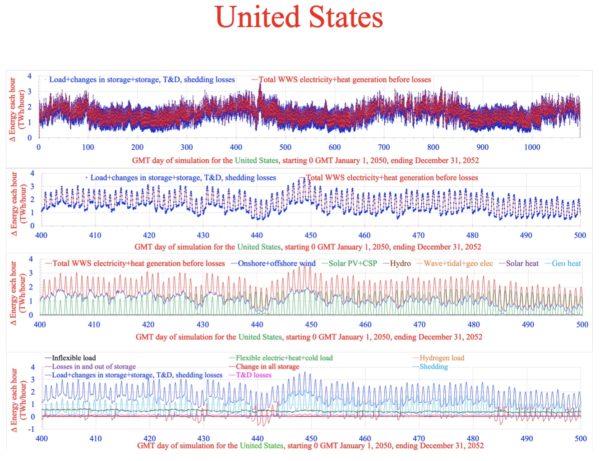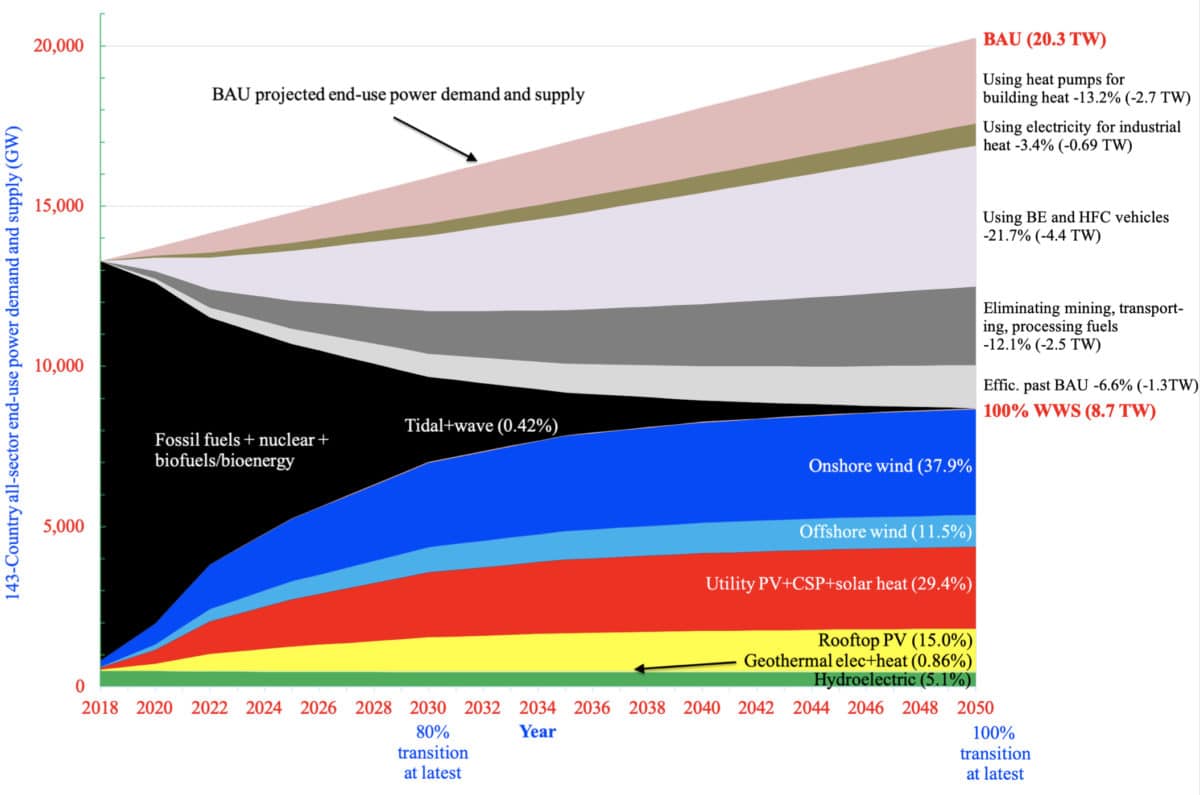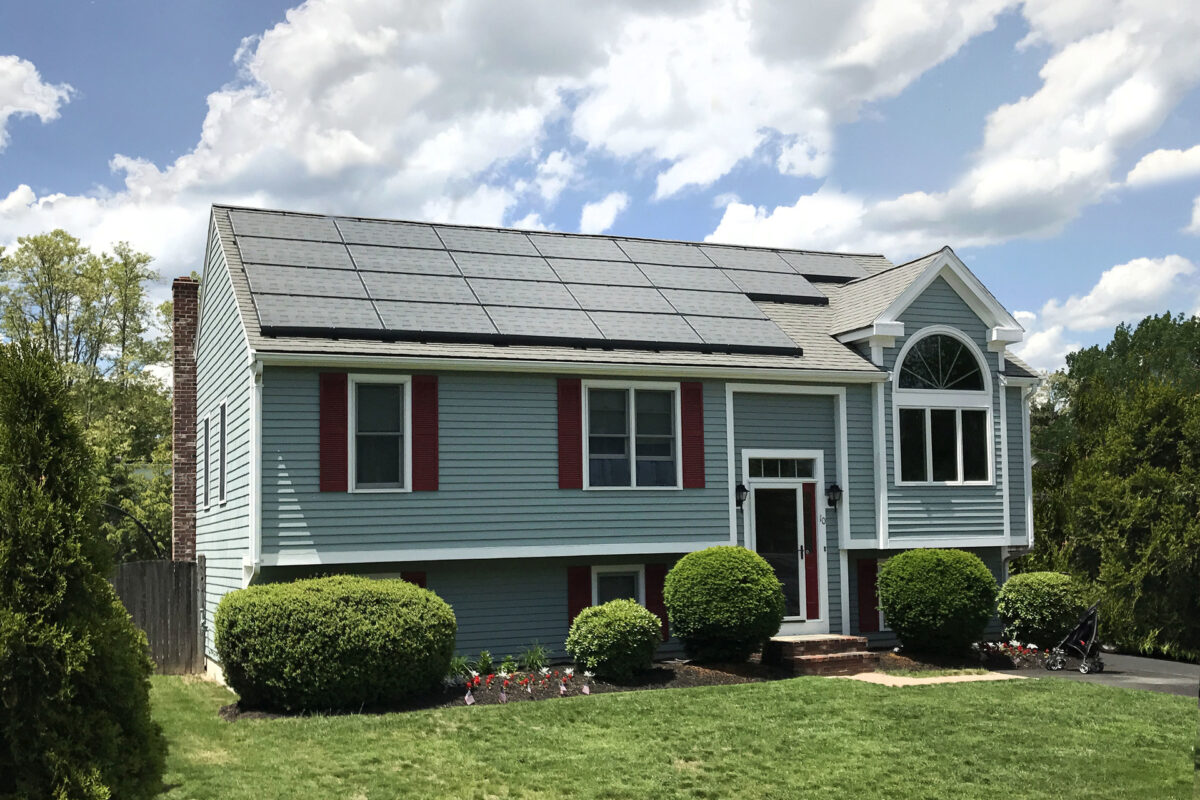The U.S. would need 1,500 GW of utility-scale solar power and 500 GW of rooftop solar to reach 100% renewable energy by 2050, according to a plan developed by Stanford engineering professor Mark Jacobson and seven co-authors. Battery capacity of 3,300 GW would balance solar and wind power — helped by 512 GW of annual average flexible load.
Several states have adopted a policy goal along the lines of 100% renewable electricity by 2050, yet the Stanford plan would go further by electrifying all transportation and heating. Flexible load to help balance variable renewables would include use cases for storing cold, storing heat, demand response, and production of hydrogen for use in trucks powered by fuel cells.
The authors say “we must stop” 80% of fossil fuel emissions by 2030 to avoid 1.5°C global warming, citing a previous study. Reaching 80% of the plan’s ultimate U.S. solar target by 2030, starting from the current level of about 75 GWdc, would require a 36% compound annual growth rate in solar installations, based on a DC-AC ratio of 1.33. That 36% rate is notably more aggressive than the 18% annual growth targeted by the Solar Energy Industries Association.
Reaching 80% of the Stanford plan’s ultimate 3,300 GW of battery capacity by 2030, starting from the current U.S. level of 1 GW, would require a compound annual growth rate of just over 100%. That compares with an Energy Storage Association post quoting Tom Leyden, Senior Director of EDF Renewables North America, saying, “Over the next 3 to 5 years, you’re going to see tremendous growth” in storage, as “some of the consultants figure there’ll be a 14 times growth over the next four or five years,” whereas a 3-year timeframe would represent an annual growth rate in installations of 100%.
Consumers would save 64% on their annual energy costs in 2050 under the plan, compared to a “business as usual” scenario, due to low-cost solar and wind power, plus savings from energy-efficient heat pumps, electric vehicles, and fuel cell vehicles. Savings when counting avoided deaths and illness from air pollution, and climate benefits, are greater—with costs 87% lower than the “business as usual” case.
The plan identifies several industrial processes that can largely operate at times of high renewable generation, thus providing flexible load: “air liquefaction; induction and ladle metallurgy; water pumping with variable speed drives; and production by electrolysis of aluminum, chlor-alkali, potassium hydroxide, magnesium, sodium chlorate, and copper.” Other research has identified a means of operating desalination as a flexible load as well.
The roadmap, which consists of plans for each region of the world, would need “only 0.17% and 0.48% of land for footprint and space, respectively” on a global basis, say the authors.
To conduct their analysis, the Stanford researchers used the LOADMATCH model, which “matches the variable supply of energy with variable demand, storage, and demand response … every 30 seconds in each region from 2050 to 2052,” as illustrated in this complex set of graphs, which the paper explains:

The modeling made a simplifying assumption of “perfect transmission”—that is, no transmission congestion. The paper cited previous research showing that if long-distance transmission congestion is an issue, “increasing the transmission capacity will relieve congestion with only a modest increase in cost.”
The Stanford team’s paper, “Impacts of Green New Deal Energy Plans on Grid Stability, Costs, Jobs, Health, and Climate in 143 Countries,” was published in the journal One Earth and is also available as a PDF.
This content is protected by copyright and may not be reused. If you want to cooperate with us and would like to reuse some of our content, please contact: editors@pv-magazine.com.








Really good to hear! In 2012, I predicted solar would grow at a 25% rate, which leads to about the same results.
I believe this will happen, and then, the solar/battery option will literally become exponential by 2029, to cover over 1% of the land by mid century, enough to finally stop all poverty in a continued growth setting.
By the turn of the century, about 2% of the oceans could be covered (somehow) by arrays, providing all the energy needed to become a true space faring race, too.
the best plan for renewable energy is to build hydrogen economy. Battery is not good for energy plants. It is better to use hydrogen for energy plants. Build big regional hydrogen production factories. Build big regional INDEPENDENT hydrogen fuel cell modules in adjacent areas around regional hydrogen production factories. All renewable energy plants and some other energy plants in regions should send electricity to big regional hydrogen production factories. All household rooftop solar farms should send electricity to regional hydrogen production factories. It is even normal to set up mind that many renewable energy plants are exclusively only for producing hydrogen. When renewable energy falls in some time or period, then use electricity from big regional fuel cell modules.
Hydrogen can be stored in liquid form. But can store hydrogen in compressed gas formed too, especially in hydrogen production factories. Hydrogen can be distribute in liquid form. And can produce standard sized compressed hydrogen canisters to distribute standard sized compressed hydrogen canisters too. (buy hydrogen by exchanging empty canister for full compressed hydrogen canisters).
Some countries, for example the US, can become world big hydrogen exporters. A lot of autonomous social activities will be powered by hydrogen fuel cell modules. Winter heating will be power by hydrogen fuel cells too.
A lot of countries and clients will prefer to buy hydrogen for winter heating instead of oil and gas, because hydrogen does not pollute their regions while oil and gas do pollute their regions.
I do believe that you are correct and it should be where people put their research investment. A much bigger picture.
It’s very funny that the study accounts for the decrease in mining from stopping the extraction of coal and gas, but do not take into account the increase in mining from building millions of wind turbines and solar panels. Really, from Stanford University, I would have expected a more serious analysis.
“The U.S. would need 1,500 GW of utility-scale solar power and 500 GW of rooftop solar to reach 100% renewable energy by 2050, according to a plan developed by Stanford engineering professor Mark Jacobson and seven co-authors. Battery capacity of 3,300 GW would balance solar and wind power — helped by 512 GW of annual average flexible load.”
Yeah the same Mark Jacobson that filed lawsuits against his so called peers. Something like, “Jacobson, we can meet 100% demands in this way.”
Peers, “There are several assumptions that are not tenable.”
Jacobson, “I’ll sue, I’ll sue.”
Peers, “See ya in court.”
I understand Jacobson dropped his suit, now why was that? Did he expect Stanford to pay his court costs? Did some of his peers ‘points’ actually survive scrutiny?
Folks, its up to you, not academics with shiny power point displays to help ‘educate the public’. Sooner or later it will be “required” for John Q and Jane Q public to open up their wallets and pay more for energy as a whole or adopt the technology and except taking responsibility for one’s daily energy needs.
The paper responds in depth to the academic challenge, providing substantive information to let each reader decide.
Can Abstract Exchange please reveal his/her identity…..
Because some states (northern tier and Alaska) receive little daylight some parts of the year, solar will probably be prohibited due to the battery requirement there.
Not to worry. As prices continue to plummet for solar, no-battery solar prices will at some point become ridiculously cheap in southern areas. Existing (or as yet undeveloped) clean, carbon neutral synthetic fuels too expensive to produce today due to the cost of electricity required to make them will ultimately become cheaper than anything pumped out of the ground and refined. Oversized solar farms in those areas will be able to power manufacturing plants for one or more of these fuels, which can then be transported using existing networks to northern tier areas to power existing oil and gas plants.